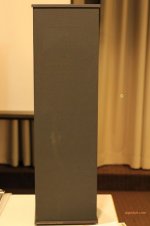could be, and especially if you are building better ones 😉
sorry I interrupted
Call the marketing boys.
Pluto was developed off the Shoulder of Orion by Quantum Mechanics.
I'm thinking what is needed is a three mic array, think of it as RPS instead of plain DRC.
what is RPS?
well, it's Room Positioning System, of course...
what is RPS?
well, it's Room Positioning System, of course...
I will in a not so far future begin some prototyping. My thoughts and some sketches can be seen here
http://www.diyaudio.com/forums/multi-way/190815-dipole-monopole.html
http://www.diyaudio.com/forums/multi-way/190815-dipole-monopole.html
one of great advocates of omnis "the digital guru" AES fellow John Watkinson and his omnidirectional active "Legend" speakers at "The European 3D-Stereo Summit, Liege, 5-11 December 2010
photos by Monika Bracha in whose words:
more: The European 3D-Stereo Summit, Liege, 5-11 December | Monika Bracha
and: Picasa Web Albums - Monika Bracha - The 3D-Stereo...
photos by Monika Bracha in whose words:
The next day we also spent at the workshops – we were so surprised, as we were expecting to be put to work by then! This time the most interesting presentation was by John Watkinson, who demonstrated the Celtic omnidirectional loudspeakers – his own invention. They were jaw-dropping. I can’t even compare them to anything as I’ve never seen, or heard, anything even close. It was just magic – the sound never changed even when one side of the speaker was covered with a jacket! The sound just WAS, as if it was air…
more: The European 3D-Stereo Summit, Liege, 5-11 December | Monika Bracha
and: Picasa Web Albums - Monika Bracha - The 3D-Stereo...
Attachments
SERVER MAINTENANCE PAGEAny further info of that Celtic omnidirectional loudspeakers ? I can't find any on the web.
Any further info of that Celtic omnidirectional loudspeakers ? I can't find any on the web.
Hi CLS!
Celtic Audio website is down perhaps because of this:
TSL acquires Celtic Audio - main-content | PSNE Magazine Online & In Print
but You can find some information on Watkinson's speakers here on the forum
do an andvanced forum search for cabar or legend author: phase_accurate
You may also check this whole thread too: http://www.diyaudio.com/forums/multi-way/105136-putting-science-back-into-loudspeakers.html
ps.
knowing Watkinson's speaker design principles it can be safely said that "Legends" are designed to be time coherent and diffraction free - perhaps two major differences between them and a typical omni
knowing Watkinson's speaker design principles it can be safely said that "Legends" are designed to be time coherent and diffraction free - perhaps two major differences between them and a typical omni
Hello,
I think this could be one of the key points indicating the direction we should be heading. The tests experienced in stereolith thread confirm this.
But how to achieve it in practise? Can an omni do it? Omni has the problem it illuminates the contralateral wall as much as the ipsilatelar one. Clearly directivity pattern higher than omni would be needed. 180 deg half omni perhaps, aimed sideways.
Ceiling and floor should be illuminated too, because it's the only way to keep the energy longer on one side of the room.
Another option is to use Ambiophonics style room divider baffle 😀 Maybe that's one reason why Ambiophonics sound so good 😉
- Elias
I think this could be one of the key points indicating the direction we should be heading. The tests experienced in stereolith thread confirm this.
But how to achieve it in practise? Can an omni do it? Omni has the problem it illuminates the contralateral wall as much as the ipsilatelar one. Clearly directivity pattern higher than omni would be needed. 180 deg half omni perhaps, aimed sideways.
Ceiling and floor should be illuminated too, because it's the only way to keep the energy longer on one side of the room.
Another option is to use Ambiophonics style room divider baffle 😀 Maybe that's one reason why Ambiophonics sound so good 😉
- Elias
...
The left channel stays longer and louder on the left side of the room, and the right channel stays longer and louder on the right side of the room.
IMO this is a fundamental aspect that needs to be improved over current traditional stereo reproduction.
Hello,
I think this could be one of the key points indicating the direction we should be heading. The tests experienced in stereolith thread confirm this.
But how to achieve it in practise? Can an omni do it? Omni has the problem it illuminates the contralateral wall as much as the ipsilatelar one. Clearly directivity pattern higher than omni would be needed. 180 deg half omni perhaps, aimed sideways.
Ceiling and floor should be illuminated too, because it's the only way to keep the energy longer on one side of the room.
Another option is to use Ambiophonics style room divider baffle 😀 Maybe that's one reason why Ambiophonics sound so good 😉
- Elias
Been out for a while again; good post!
Actually it doesn't "illuminate" the two walls equally. There is intensity loss with distance. It's also a "tighter grouping" of intensity on the near-wall side. I think this aspect partially improves the presentation when compared to more traditional and directional loudspeakers. The "omni" or radial spreads it all out evenly - a multiplicity of reflections with a greater intensity on one side (the "near" side) versus the other ("far" side or contralateral).
I do think you have it right though - improvement is needed in the design beyond an omni.
Waveguide or cardioid are your two options.
A traditional waveguide doesn't sound "right" to me. Diffraction is a problem, but I think the greater problem is intensity shading - in that you can't "lock-in" on it. The change at higher freq.s is also to *much* or "abrupt" with most waveguides.
That leaves cardioid - which is really tough to design when considering the pressure loss of both the radial config. and now the loss from the cardioid. Also it would likely have to be accomplished with a complicated two-driver "array" at higher freq.s. The only person I'd consult with on that would be Johnk, and it would almost certainly be "active" through-out.
Perhaps however a precisely engineered solution of an absorptive waveguide could be made?
Last edited:
If a speaker was full omni for the lower end, and half-space at the upper end, with the full/half-space transition centered at 2.6 kHz, how would it sound? Does the treble need to be omni?
At the very least it would be omni higher up than the Pluto which by most accounts sounds excellent at low and medium volumes.
At the very least it would be omni higher up than the Pluto which by most accounts sounds excellent at low and medium volumes.
just wibni? why not?
Would most be able to tell the difference between such significantly varied speaker designs in a blind audition? Are blind audtions ever actually done in reviews? I haven't kept up on that side of things in a long time.
Would it seem presumtively insulting to set up a test theater/booth at an audio trade show, with seating provided before a curtained area wherein various types/methods/constructs of sound reproduction were auditioned and surveys then completed as to overyal quality ratings, source identity, and some meaningful assortment of common criteria (soundstage, tonality, dynamics, and etc)? Live acoustic (no amps) performace included in the mix.
I"ve never attended a trade show. Long ago, high school, I worked one summer with a guy downtown who ran an audio shop., He used to attend the shows. I remember him wondering one day, cynically, how he might be recieved if he were to set up a booth with a visually opaque but sonically transparant curtain, hire a live acoustic trio to sit it for the day, and welcome all comment on his loudspeaker design.
Any guesses here (seriously, I'm not being cynical now) as to the outcome of this if a large number of audio enthusiasts were asked to distinguish between a variety of Omni designs and 'conventional' designs? Same content, adjusted for sensitivity, etc?
Would most be able to tell the difference between such significantly varied speaker designs in a blind audition? Are blind audtions ever actually done in reviews? I haven't kept up on that side of things in a long time.
Would it seem presumtively insulting to set up a test theater/booth at an audio trade show, with seating provided before a curtained area wherein various types/methods/constructs of sound reproduction were auditioned and surveys then completed as to overyal quality ratings, source identity, and some meaningful assortment of common criteria (soundstage, tonality, dynamics, and etc)? Live acoustic (no amps) performace included in the mix.
I"ve never attended a trade show. Long ago, high school, I worked one summer with a guy downtown who ran an audio shop., He used to attend the shows. I remember him wondering one day, cynically, how he might be recieved if he were to set up a booth with a visually opaque but sonically transparant curtain, hire a live acoustic trio to sit it for the day, and welcome all comment on his loudspeaker design.
Any guesses here (seriously, I'm not being cynical now) as to the outcome of this if a large number of audio enthusiasts were asked to distinguish between a variety of Omni designs and 'conventional' designs? Same content, adjusted for sensitivity, etc?
Last edited:
Absorptive waveguide?
Hmmm... The tweeter of EV sentry 100a?
The original 100a is interesting. Smaller cells near the driver, larger cells further away. (..a search picks-up several with latter incorrect replacements.) I guess it ultimately depends on the actual radiation pattern with the addition of the high-pass filter.
Peace, it's been done a couple times. Dipole fans are discontent with the results yet. Conventional/wide pattern uniform off axis speaker lovers are saying "I told you so". I don't recall any with omnis involved.
he he,
Dan
he he,
Dan
If a speaker was full omni for the lower end, and half-space at the upper end, with the full/half-space transition centered at 2.6 kHz, how would it sound? Does the treble need to be omni?
At the very least it would be omni higher up than the Pluto which by most accounts sounds excellent at low and medium volumes.
In that sort of configuration treble sounds bright (depending on the axis you listen to) with overpowering bass. Generally statements that are "at odds" with each other, but the treble get's subjectively emphasized where it becomes directional and you listen to that direction. Of course the total output of the omni bass section is louder than the directional treble.
If we consider how we hear, then optimally there should be a greater emphasis (spl) at 90 degrees horizontally left of left, and 90 degrees horizontally right of right. This sort of configuration provides:
1. Decreased interaural cross correlation (..or better apparent separation between channels), and
2. Effective compensation for an axis where we don't hear as well (i.e. anything past about 60 degrees horizontally is more difficult to hear).
To some extent omni/radials improve both aspects over a conventional design.
While they don't *compensate* for the 90 degree axis-range, they are at least providing it at higher freq.s where we are more sensitive to spl changes. More common designs become increasingly directional at higher freq.s and simply loose pressure off-axis providing a "forward" +/-45 degree emphasis (in the range where we are most acutely aware). The down-side here is that the output left of right (which radiates to the far wall or contralateral wall) is ALSO being provided and this *increases* interaural cross correlation. (..this does however have the benefit of creating a more stable image for listener's off-axis). On the other hand..
As mentioned previously, the total apparent spl of the near wall reflections tends to make the speaker closer to that wall sound louder, and more specifically louder at that off-axis angle. For a radial/omni the loudest grouping is the closest which is in the 90 degree range. So to some extent interaural cross correlation is improved.
Again though, a far better result would be obtained with a cardioid pattern with the dominate spl aimed at the nearest side-wall. i.e. left speaker aimed at left wall, right speaker aimed at right wall, increasing pressure loss as you move toward center. This would be lousy though for anyone sitting off-axis. It could also be improved by moving the loudspeakers closer together and listening closer to the loudspeakers.
just wibni? why not?
Would most be able to tell the difference between such significantly varied speaker designs in a blind audition? Are blind audtions ever actually done in reviews? I haven't kept up on that side of things in a long time.
Would it seem presumtively insulting to set up a test theater/booth at an audio trade show, with seating provided before a curtained area wherein various types/methods/constructs of sound reproduction were auditioned and surveys then completed as to overyal quality ratings, source identity, and some meaningful assortment of common criteria (soundstage, tonality, dynamics, and etc)? Live acoustic (no amps) performace included in the mix.
I"ve never attended a trade show. Long ago, high school, I worked one summer with a guy downtown who ran an audio shop., He used to attend the shows. I remember him wondering one day, cynically, how he might be recieved if he were to set up a booth with a visually opaque but sonically transparant curtain, hire a live acoustic trio to sit it for the day, and welcome all comment on his loudspeaker design.
Any guesses here (seriously, I'm not being cynical now) as to the outcome of this if a large number of audio enthusiasts were asked to distinguish between a variety of Omni designs and 'conventional' designs? Same content, adjusted for sensitivity, etc?
"Most" probably wouldn't tell a difference that they could readily quantify - even knowing that there are different radiation patterns.
On the other hand those accustomed to dipoles and omni's vs. more traditional designs would likely be aware - immediately so.
The testing I've read that includes dipoles vs. non-dipoles has usually been done in larger spaces where greater absorption is on the room walls - effectively removing the contribution the "splashy" effect of greater output at higher freq.s due to room reflections. When this is done the differences are reduced (between the types of designs), largely because the frontal patterns aren't that dissimilar between the two designs at higher freq.s. The major differences however would be related to the midrange and midbass, where the output would effectively be lower off-axis for the dipole. (i.e. there wouldn't be a midrange emphasis.)
Is this a tricky question? 😉 What you describe is the conventional 2-way box speaker! Omni at the bass and directional at the treble. How would it sound?? It would sound like a box speaker! Isn't this what we would like to improve and are looking for better alternatives.
I think, better is to have it just the other way around: High directional at the bass and low directional at the treble. Treble may not neccessarily need to be an omni though.
- Elias
I think, better is to have it just the other way around: High directional at the bass and low directional at the treble. Treble may not neccessarily need to be an omni though.
- Elias
If a speaker was full omni for the lower end, and half-space at the upper end, with the full/half-space transition centered at 2.6 kHz, how would it sound? Does the treble need to be omni?
Is this a tricky question? 😉 What you describe is the conventional 2-way box speaker! Omni at the bass and directional at the treble. How would it sound?? It would sound like a box speaker! Isn't this what we would like to improve and are looking for better alternatives.
I think, better is to have it just the other way around: High directional at the bass and low directional at the treble. Treble may not neccessarily need to be an omni though.
- Elias
Most 2-ways aren't omni until below 500 Hz - the "bottom-end" of their "baffle-step" loss region. 😉
The Pluto is effectivly omni up to almost 3 kHz, due to the radial midbass and the small diameter tweeter with no real baffle (which effectively operates below it's own "baffle step" region).
Last edited:
- Home
- Loudspeakers
- Multi-Way
- Why are OMNI speakers not more popular?


